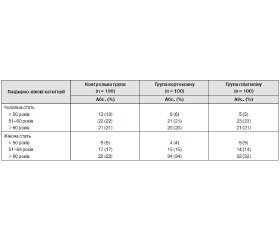Международный неврологический журнал 5 (75) 2015
Вернуться к номеру
Administration of neuroprotectors at the prehospital phase of acute stroke and their influence on long-term consequences of stroke
Авторы: Smolko D.G.
Рубрики: Неврология
Разделы: Клинические исследования
Версия для печати
Background. Stroke is the stable actual problem in Neurology. Despite the neuroprotectors effectiveness in researches on models of cerebral ischemia, the results of clinical trials with administration of neuroprotectors remain controversy.
Purpose. Primary objective of this study was to evaluate the appropriateness of neuroprotectors administration (Сortexin, Gliatilin) in early stages of acute strokes and their influence on the long-term consequences of brain stroke, based on the assessment of neurological status (scale NIHSS).
Materials and methods. The study had been conducted from January to December 2013 at neurological departments of three districts in Vinnitsa region (Vinnitskiy, Khmelnytskyi and Haysynkyi). Number of stroke episodes in these areas in 2013 were 807, 460 and 505 cases, respectively. Study participants were divided into 3 groups of 100 patients each. Patients comparison group received conventional treatment without neuroprotectors. Patients of the other two groups at the initial examination in addition to standard care was administrated neuroprotectors – Cortexin 20 mg intramuscularly (group Cortexin) or Gliatilin 1000 mg intramuscularly (group Gliatilin). For all the patients we performed neurological and general clinical examination. All the patients came were hospitalized in 1-2 days after the onset of stroke. National Institutes of Health Stroke Scale (NIHSS) was used for evaluation of the neurological disability. NIHSS examination was performed at the time of admission to hospital, on the 15-th day of treatment and after 1 year from the date of stroke onset.
Statistical data processing was performed in the statistical package SPSS 20 (© SPSS Inc.).
Results. The study included 300 patients with acute stroke, 152 men (51%) and 148 (49%) women. The age of patients was from 34 to 74 (mean – 57.3 ± 8.26) years. Groups comparison was similar to each other by sex, average age, frequency and structure of somatic pathology, mean time between the stroke episode onset and hospitalization, severity of disability using the scale NIHSS at initial examination (p˃0.05). The analyzed patients were similar in severity of brain dysfunction from 7 to 30 points on the NIHSS scale at the baseline of the study. The analysis of the neurological disability showed that administration of neuroprotectors at the prehospital phase of stroke contributes to significant reduction of disability by NIHSS scale at the 15-th day of treatment with Cortexin to 19.4%, and Gliatilin – 27.2% respectively, compared to the rate of the comparison group (p<0.001 and p=0.012, respectively). The most distinct difference in results was shown with the evaluation of disability after 1 year after the stroke episode onset. NIHSS score was lower by 29.5% in the Cortexin group and by 23.2% in the Gliatilin group (p<0.001 and p=0.016, respectively) compared to the rate of the control group. The optimal time for the start of the neuroprotectors administration (Cortexin or Gliatilin) is the first hour after the onset of the first symptoms of acute stroke.
Conclusion. The statistical analysis showed more rapid regression of neurological status in groups of Cortexin and Gliatilin, indicating significant neuroprotective effect of these drugs. Confirmed the appropriateness of neuroprotectors administration at the prehospital phase of acute cerebral accident.

